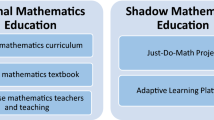Abstract
In this chapter, we provide context and information regarding the mathematics resources used in Ontario, Canada and Mainland China’s elementary math classrooms. An overview of the types of textbooks and how they are used by teachers in both Ontario, Canada and China is shared. Schools in Ontario select from a list of textbooks approved by the government. In China, the government provides a list of mandated textbooks for all subjects. Furthermore, this chapter describes the other forms of resources commonly used in elementary mathematics education such as technology and manipulatives for teaching mathematics. We also give readers a glimpse into the classroom life of Chinese and Canadian elementary school students as the setting for their learning impacts how they learn and interact with available resources.
Access this chapter
Tax calculation will be finalised at checkout
Purchases are for personal use only
Similar content being viewed by others
References
Appelgate, M., Jackson, C., Jurgenson, K., & Delaney, A. (2018). Introducing mathematics concepts using STEM Connections. Teaching Children Mathematics, 24(6), 394–397.
Bai, R. (2018). Discussion about how to strengthen the cultivation of students’ innovative consciousness in elementary mathematics teaching. Curriculum Education Research, 5, 154.
Ball, D. L., Hill, H. C., & Bass, H. (2005). Knowing mathematics for teaching: Who knows mathematics well enough to teach third grade, and how can we decide? American Educator, 29(1), 14–17, 20–22, 43–46.
Boaler, J. (2014). The mathematics of hope: Moving from performance to learning in mathematics classrooms. Heinemann Blog. Retrieved from https://blog.heinemann.com/the-mathematics-of-hope-moving-from-performance-to-learning-in-mathematics-classrooms.
Dewey, J. (1933). How we think: A restatement of the relation of reflective thinking to the educative process. Boston: Henry Holt.
Li, C., & Zhang, J. (2001). Concept and implementation of intelligent knowledge platform. World Science and Technology Research and Development, 23(6), 1–6.
Li, L., & Zhu, R. (2005). On the management of classroom teaching environment in primary and middle schools. Education Management and Evaluation, 8, 64–66.
Li, R. (2011). The negative effects and suggestions of traditional classroom seating arrangement. Teaching and Management (Secondary Edition), 27–29.
Ministry of Education of the People’s Republic of China. (2012). Mathematics curriculum standards for compulsory education (2011 Edition: 4−5). Beijing: Beijing Normal University Press.
Ministry of Education of the People’s Republic of China. (2013). National medium and long-term education reform and development program (2010–2020) [DB/OL]. http://ishare.iask.sina.com.cn/f/23136097.html.
Ma, Y. (2012). Primary school mathematics curriculum standards and textbook research. Higher Education Press, 107–129.
Ontario Ministry of Education. (2005). The Ontario Curriculum 1−8: Mathematics. Ontario: Queen’s Printer for Ontario.
Sleeter, C. E., & Grant, C. A. (2011). Race, class, gender and disability in current textbooks. In E. F. Provenzo & A. N. Shaver (Eds.), The textbook discourse: Sociocultural dimensions of American schoolbooks. New York, NY: Routledge.
Wang, G., & Yang R. (2013). Evaluation standards of mathematics teaching design integrated with information technology. China Audio-Visual Education (11), 106–109 + 125.
Yan, J. (2015). An empirical study on the relationship between “teacher use textbook level” and classroom teaching effect: Taking elementary mathematics as an example. Northeast Normal University Press, 1.
Zhu, Y. (2017). Practical research on expanded curriculum of primary school mathematics under STEAM concept. Curriculum Teaching Research, 0(10), 88–94.
Author information
Authors and Affiliations
Corresponding author
Editor information
Editors and Affiliations
Rights and permissions
Copyright information
© 2020 The Author(s)
About this chapter
Cite this chapter
Xie, S., Zhu, S.C., Huang, J. (2020). Mathematics Resources in Ontario, Canada and Mainland China. In: Zhu, S.C., Xie, S., Ma, Y., McDougall, D. (eds) Reciprocal Learning for Cross-Cultural Mathematics Education . Intercultural Reciprocal Learning in Chinese and Western Education. Palgrave Macmillan, Cham. https://doi.org/10.1007/978-3-030-56838-2_4
Download citation
DOI: https://doi.org/10.1007/978-3-030-56838-2_4
Published:
Publisher Name: Palgrave Macmillan, Cham
Print ISBN: 978-3-030-56837-5
Online ISBN: 978-3-030-56838-2
eBook Packages: EducationEducation (R0)




